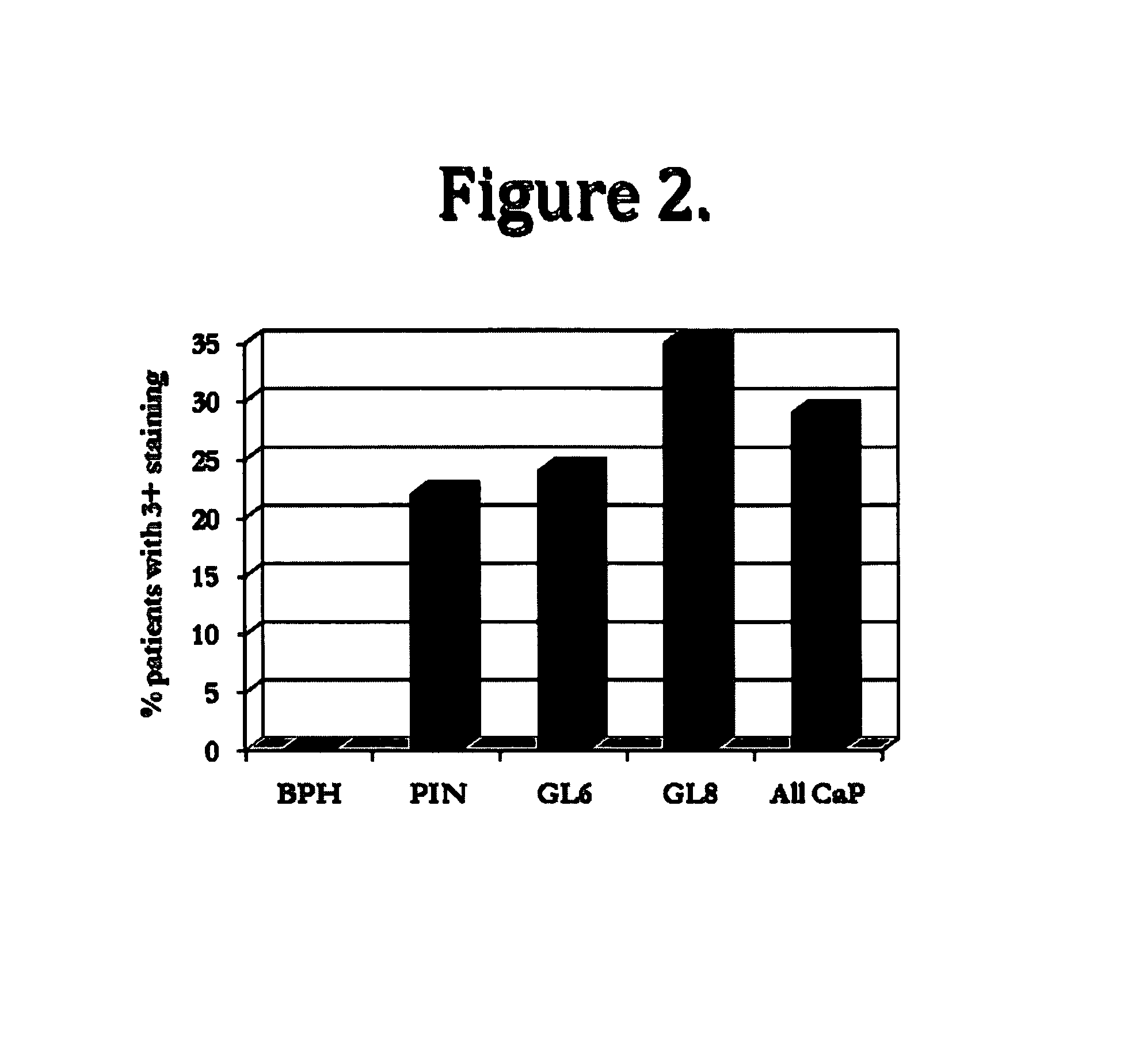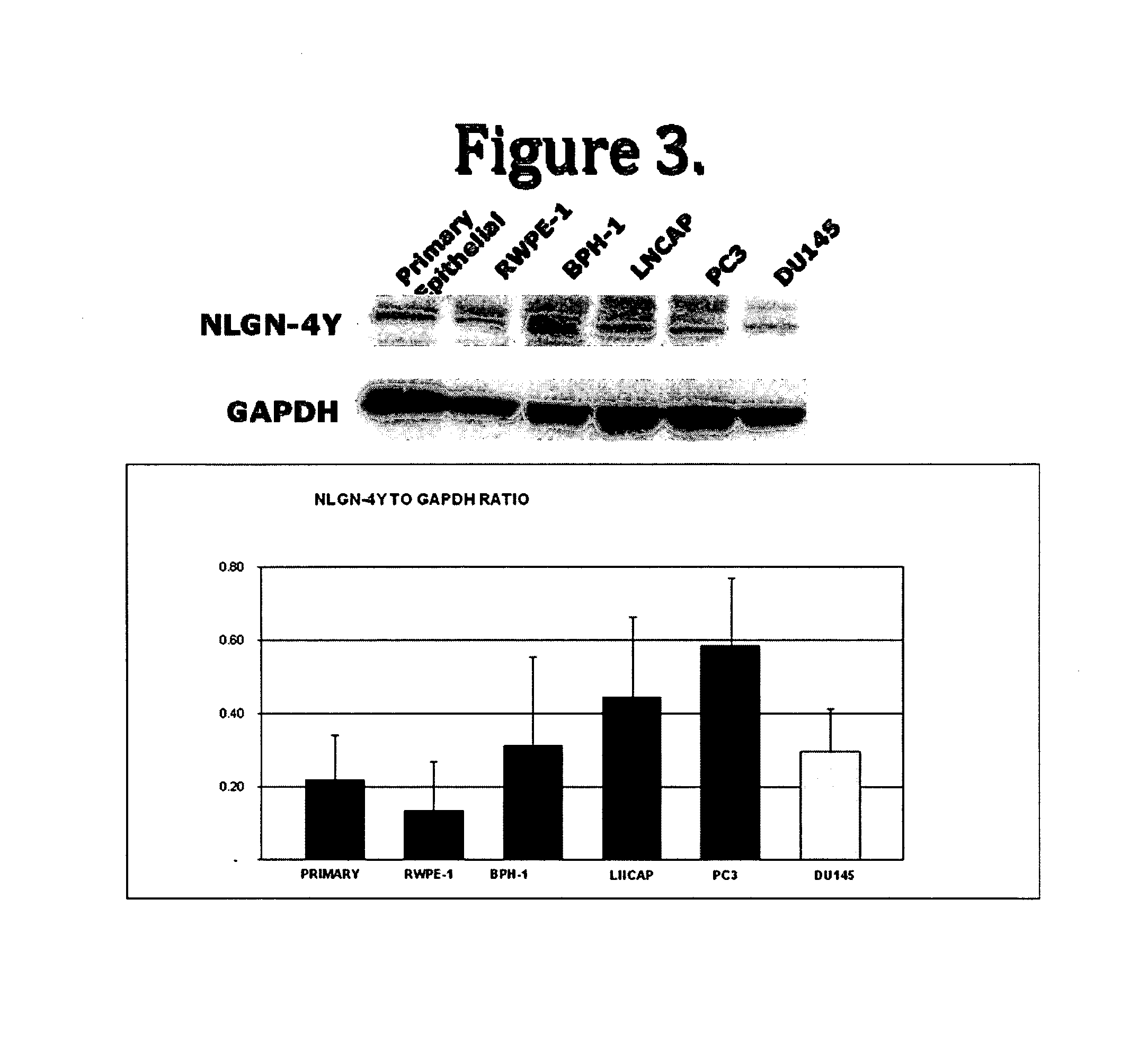Biomarkers for prostate cancer
a biomarker and prostate cancer technology, applied in the field of compositions and methods for detecting, treating and empirically investigating prostate cancer, can solve the problems of intense scrutiny of psa screening
- Summary
- Abstract
- Description
- Claims
- Application Information
AI Technical Summary
Benefits of technology
Problems solved by technology
Method used
Image
Examples
examples
[0099]The following examples are provided in order to demonstrate and further illustrate certain preferred embodiments and aspects of the present invention and are not to be construed as limiting the scope thereof.
example i
[0100]This example shows the expression pattern for NLGN4 for disorders associated with the prostate. Experiments were conducted on prostate tissue (e.g., benign prostatic hyperplasia tissue, prostatic intraepithelial neoplasia tissue, prostate cancer tissue) to characterize the NLGN4 expression within such disorders. The Gleason score represents a histological scoring system for PSA, wherein a score of 1 designates well-differentiated cells and a score of 5 designates poorly differentiated cells. The higher the score, the more advanced the cancer (Gleason, 1966, Cancer Chemother. Rep. 50:125; Gleason, 1992, Hum. Pathol. 23:273, incorporated herein by reference in their entireties))(BPH: benign prostatic hyperplasia, PIN:prostatic intraepithelial neoplasia, CaP:prostate cancer). Table 1 and FIG. 1 show that the staining (range of 0-3; 0=no staining, 3=strong staining) of the prostate tissue for NLGN-4Y increased with prostate cancer progression, and was lower for non-cancerous prost...
example ii
[0109]This example describes techniques for detecting NLGN-4Y in a human serum sample. The present invention is not limited to this particular technique.
Optimization of ELISA for Serum Samples
Prepare Coating-Reagent Dilutions
[0110]1. Place four 17·100-mm test tubes in a rack and add 6 ml PBSN to the last three tubes. In tube 1, prepare a 12-ml solution of coating Neuroligin-4Y antibody at 10 μg / ml in PBSN. Transfer 6 ml of tube 1 solution to tube 2. Mix by pipetting up and down five times. Repeat this transfer and mix for tubes 3 and 4; the tubes now contain the coating reagent at 10, 5, 2.5, and 1.25 μg / ml.[0111]2. Using a multichannel pipet, dispense 50 μl of the coating reagent solutions into wells of four Immulon microtiter plates (i.e., each plate is filled with one of the four dilutions). Incubate overnight at room temperature or 2 hr at 37° C.[0112]3. Fill each well with blocking buffer dispensed as a stream from a squirt bottle and incubate 30 min at room temperature. Rinse ...
PUM
| Property | Measurement | Unit |
|---|---|---|
| concentration | aaaaa | aaaaa |
| compositions | aaaaa | aaaaa |
| PSA | aaaaa | aaaaa |
Abstract
Description
Claims
Application Information
 Login to View More
Login to View More - R&D
- Intellectual Property
- Life Sciences
- Materials
- Tech Scout
- Unparalleled Data Quality
- Higher Quality Content
- 60% Fewer Hallucinations
Browse by: Latest US Patents, China's latest patents, Technical Efficacy Thesaurus, Application Domain, Technology Topic, Popular Technical Reports.
© 2025 PatSnap. All rights reserved.Legal|Privacy policy|Modern Slavery Act Transparency Statement|Sitemap|About US| Contact US: help@patsnap.com



